check engine HYUNDAI I20 2021 Owner's Manual
[x] Cancel search | Manufacturer: HYUNDAI, Model Year: 2021, Model line: I20, Model: HYUNDAI I20 2021Pages: 444, PDF Size: 8.93 MB
Page 258 of 444
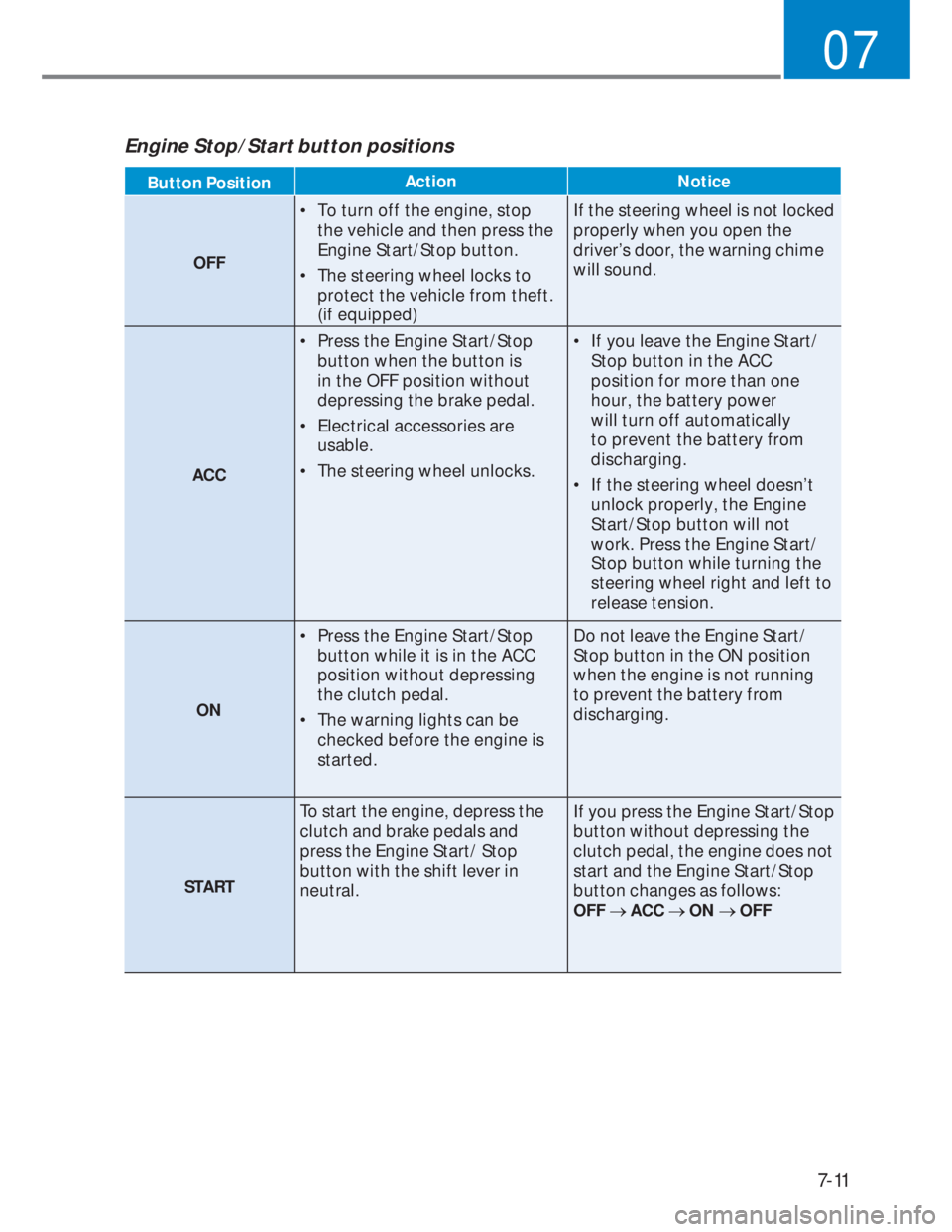
7-11
07
Engine Stop/Start button positions
Button PositionAction Notice
OFF• To turn off the engine, stop
the vehicle and then press the
Engine Start/Stop button.
• The steering wheel locks to
protect the vehicle from theft.
(if equipped)If the steering wheel is not locked
properly when you open the
driver’s door, the warning chime
will sound.
ACC• Press the Engine Start/Stop
button when the button is
in the OFF position without
depressing the brake pedal.
• Electrical accessories are
usable.
• The steering wheel unlocks.• If you leave the Engine Start/
Stop button in the ACC
position for more than one
hour, the battery power
will turn off automatically
to prevent the battery from
discharging.
• If the steering wheel doesn’t
unlock properly, the Engine
Start/Stop button will not
work. Press the Engine Start/
Stop button while turning the
steering wheel right and left to
release tension.
ON• Press the Engine Start/Stop
button while it is in the ACC
position without depressing
the clutch pedal.
• The warning lights can be
checked before the engine is
started.Do not leave the Engine Start/
Stop button in the ON position
when the engine is not running
to prevent the battery from
discharging.
STARTTo start the engine, depress the
clutch and brake pedals and
press the Engine Start/ Stop
button with the shift lever in
neutral.If you press the Engine Start/Stop
button without depressing the
clutch pedal, the engine does not
start and the Engine Start/Stop
button changes as follows:
OFF �o ACC �o ON �o OFF
Page 259 of 444
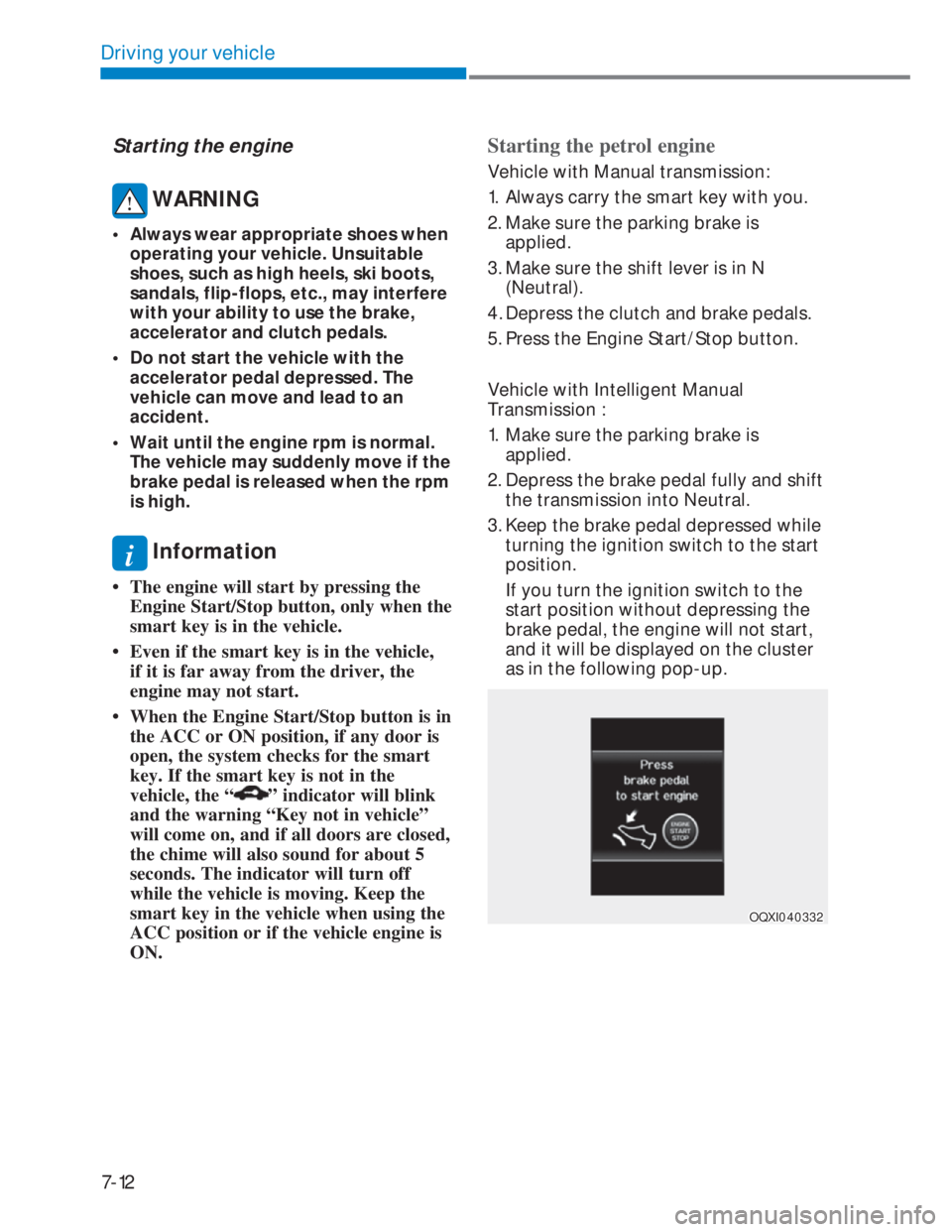
7-12
Driving your vehicle
Starting the engine
WARNING
• Always wear appropriate shoes when
operating your vehicle. Unsuitable
shoes, such as high heels, ski boots,
sandals, flip-flops, etc., may interfere
with your ability to use the brake,
accelerator and clutch pedals.
• Do not start the vehicle with the
accelerator pedal depressed. The
vehicle can move and lead to an
accident.
• Wait until the engine rpm is normal.
The vehicle may suddenly move if the
brake pedal is released when the rpm
is high.
i Information
• The engine will start by pressing the
Engine Start/Stop button, only when the
smart key is in the vehicle.
• Even if the smart key is in the vehicle,
if it is far away from the driver, the
engine may not start.
• When the Engine Start/Stop button is in
the ACC or ON position, if any door is
open, the system checks for the smart
key. If the smart key is not in the
vehicle, the “
” indicator will blink
and the warning “Key not in vehicle”
will come on, and if all doors are closed,
the chime will also sound for about 5
seconds. The indicator will turn off
while the vehicle is moving. Keep the
smart key in the vehicle when using the
ACC position or if the vehicle engine is
ON.
Starting the petrol engine
Vehicle with Manual transmission:
1. Always carry the smart key with you.
2. Make sure the parking brake is
applied.
3. Make sure the shift lever is in N
(Neutral).
4. Depress the clutch and brake pedals.
5. Press the Engine Start/Stop button.
Vehicle with Intelligent Manual
Transmission :
1. Make sure the parking brake is
applied.
2. Depress the brake pedal fully and shift
the transmission into Neutral.
3. Keep the brake pedal depressed while
turning the ignition switch to the start
position.
If you turn the ignition switch to the
start position without depressing the
brake pedal, the engine will not start,
and it will be displayed on the cluster
as in the following pop-up.
OQXI040332OQXI040332
Page 260 of 444
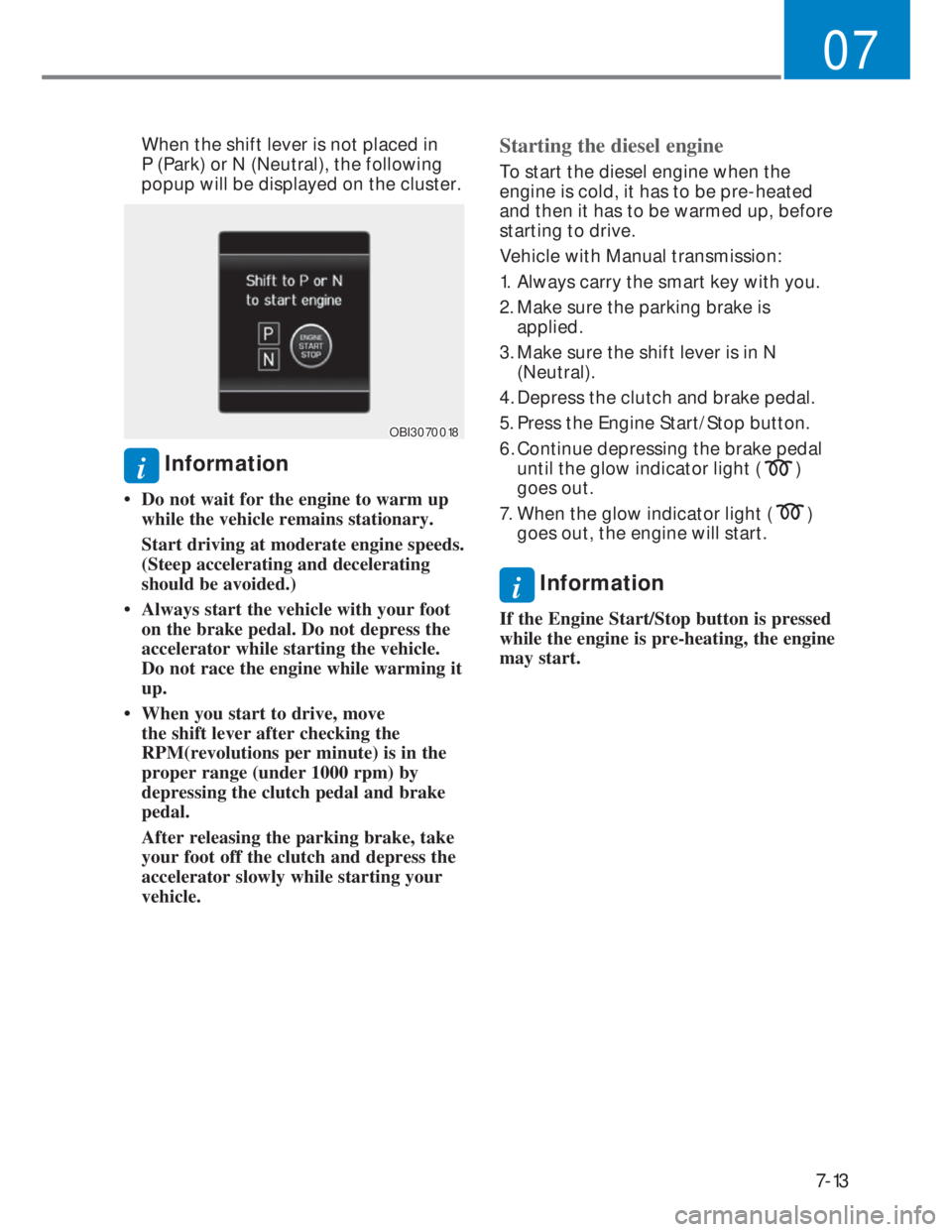
7-13
07
When the shift lever is not placed in
P (Park) or N (Neutral), the following
popup will be displayed on the cluster.
OBI3070018OBI3070018
i Information
• Do not wait for the engine to warm up
while the vehicle remains stationary.
Start driving at moderate engine speeds.
(Steep accelerating and decelerating
should be avoided.)
• Always start the vehicle with your foot
on the brake pedal. Do not depress the
accelerator while starting the vehicle.
Do not race the engine while warming it
up.
• When you start to drive, move
the shift lever after checking the
RPM(revolutions per minute) is in the
proper range (under 1000 rpm) by
depressing the clutch pedal and brake
pedal.
After releasing the parking brake, take
your foot off the clutch and depress the
accelerator slowly while starting your
vehicle.
Starting the diesel engine
To start the diesel engine when the
engine is cold, it has to be pre-heated
and then it has to be warmed up, before
starting to drive.
Vehicle with Manual transmission:
1. Always carry the smart key with you.
2. Make sure the parking brake is
applied.
3. Make sure the shift lever is in N
(Neutral).
4. Depress the clutch and brake pedal.
5. Press the Engine Start/Stop button.
6. Continue depressing the brake pedal
until the glow indicator light (
)
goes out.
7. When the glow indicator light (
)
goes out, the engine will start.
i Information
If the Engine Start/Stop button is pressed
while the engine is pre-heating, the engine
may start.
Page 269 of 444
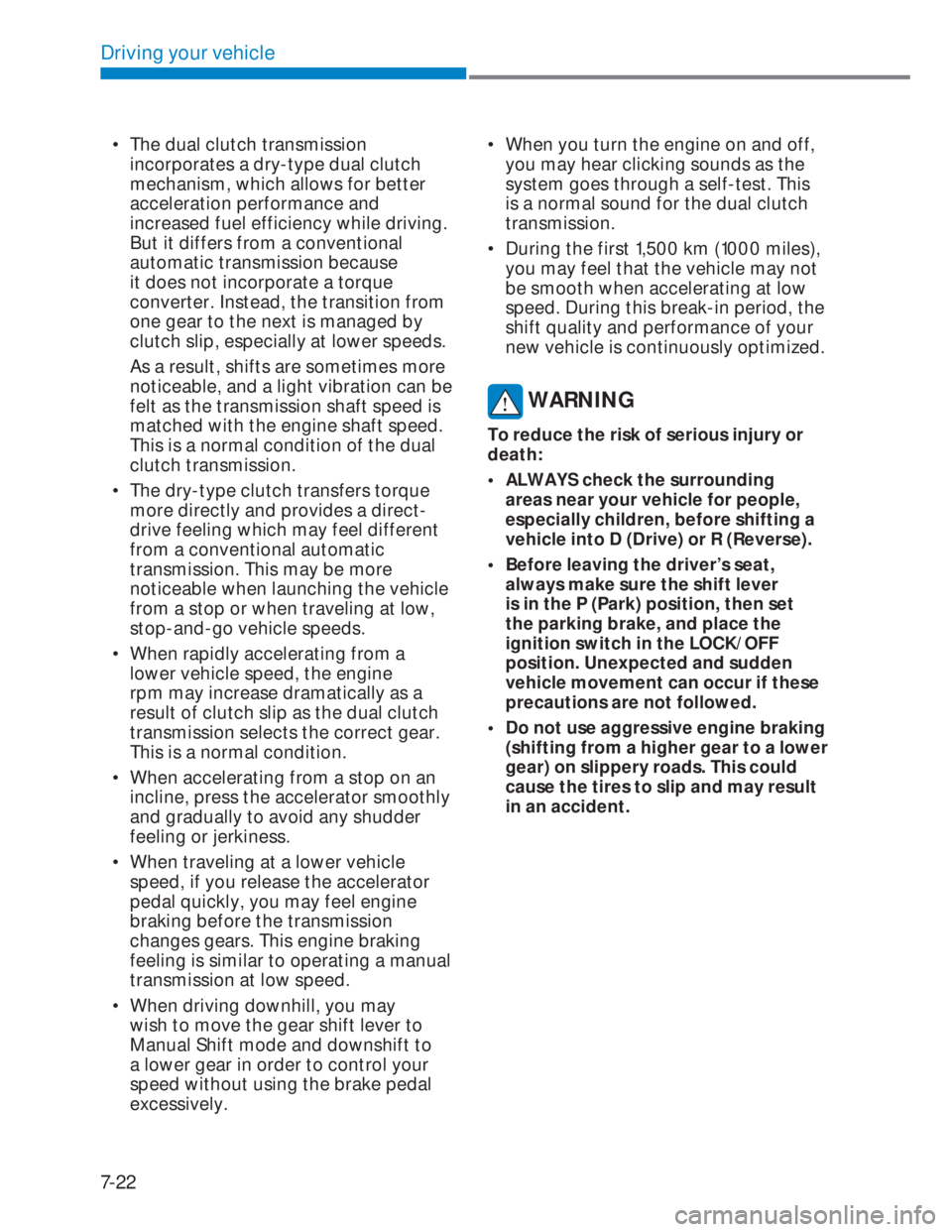
7-22
Driving your vehicle
• The dual clutch transmission
incorporates a dry-type dual clutch
mechanism, which allows for better
acceleration performance and
increased fuel efficiency while driving.
But it differs from a conventional
automatic transmission because
it does not incorporate a torque
converter. Instead, the transition from
one gear to the next is managed by
clutch slip, especially at lower speeds.
As a result, shifts are sometimes more
noticeable, and a light vibration can be
felt as the transmission shaft speed is
matched with the engine shaft speed.
This is a normal condition of the dual
clutch transmission.
• The dry-type clutch transfers torque
more directly and provides a direct-
drive feeling which may feel different
from a conventional automatic
transmission. This may be more
noticeable when launching the vehicle
from a stop or when traveling at low,
stop-and-go vehicle speeds.
• When rapidly accelerating from a
lower vehicle speed, the engine
rpm may increase dramatically as a
result of clutch slip as the dual clutch
transmission selects the correct gear.
This is a normal condition.
• When accelerating from a stop on an
incline, press the accelerator smoothly
and gradually to avoid any shudder
feeling or jerkiness.
• When traveling at a lower vehicle
speed, if you release the accelerator
pedal quickly, you may feel engine
braking before the transmission
changes gears. This engine braking
feeling is similar to operating a manual
transmission at low speed.
• When driving downhill, you may
wish to move the gear shift lever to
Manual Shift mode and downshift to
a lower gear in order to control your
speed without using the brake pedal
excessively.• When you turn the engine on and off,
you may hear clicking sounds as the
system goes through a self-test. This
is a normal sound for the dual clutch
transmission.
• During the first 1,500 km (1000 miles),
you may feel that the vehicle may not
be smooth when accelerating at low
speed. During this break-in period, the
shift quality and performance of your
new vehicle is continuously optimized.
WARNING
To reduce the risk of serious injury or
death:
• ALWAYS check the surrounding
areas near your vehicle for people,
especially children, before shifting a
vehicle into D (Drive) or R (Reverse).
• Before leaving the driver’s seat,
always make sure the shift lever
is in the P (Park) position, then set
the parking brake, and place the
ignition switch in the LOCK/OFF
position. Unexpected and sudden
vehicle movement can occur if these
precautions are not followed.
• Do not use aggressive engine braking
(shifting from a higher gear to a lower
gear) on slippery roads. This could
cause the tires to slip and may result
in an accident.
Page 272 of 444
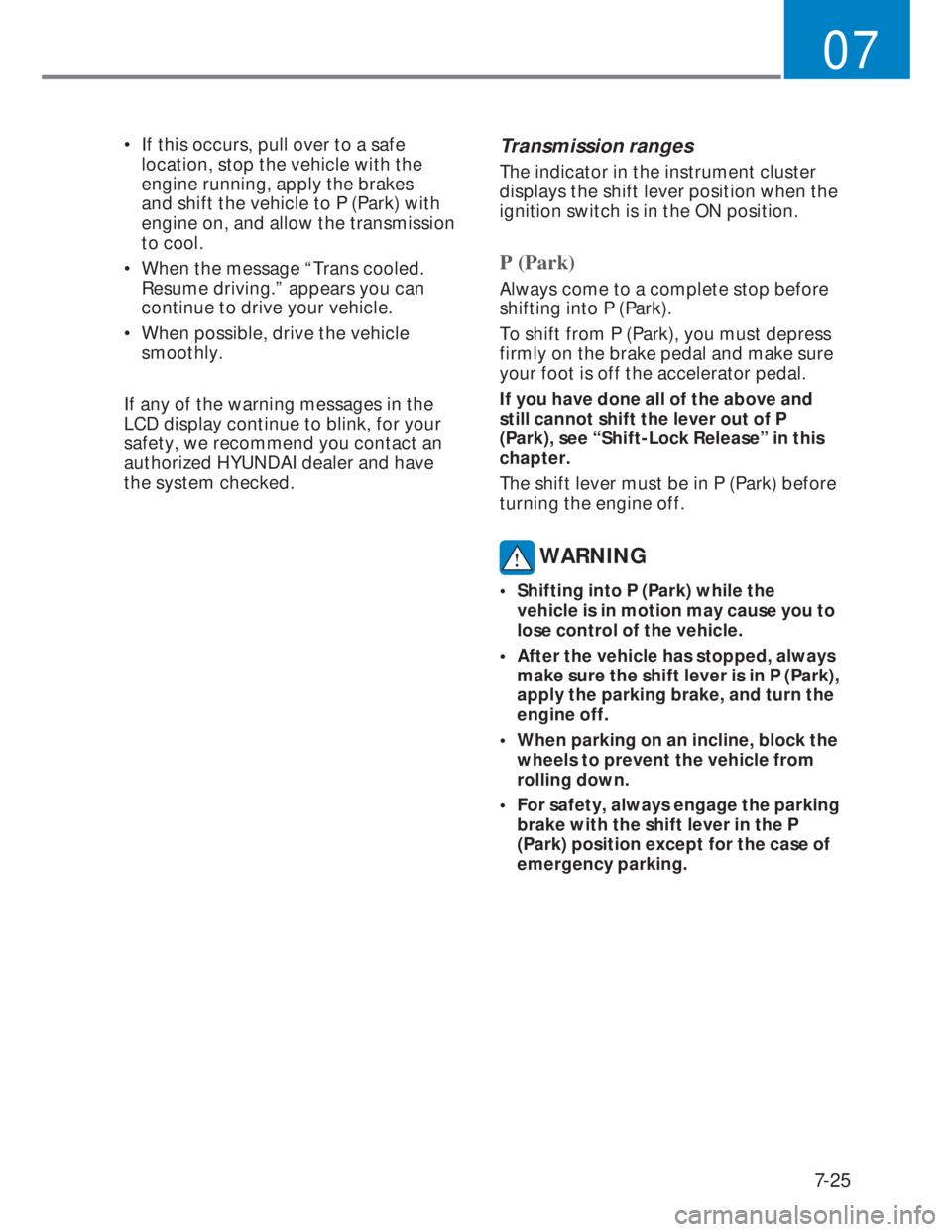
7-25
07
• If this occurs, pull over to a safe
location, stop the vehicle with the
engine running, apply the brakes
and shift the vehicle to P (Park) with
engine on, and allow the transmission
to cool.
• When the message “Trans cooled.
Resume driving.” appears you can
continue to drive your vehicle.
• When possible, drive the vehicle
smoothly.
If any of the warning messages in the
LCD display continue to blink, for your
safety, we recommend you contact an
authorized HYUNDAI dealer and have
the system checked.Transmission ranges
The indicator in the instrument cluster
displays the shift lever position when the
ignition switch is in the ON position.
P (Park)
Always come to a complete stop before
shifting into P (Park).
To shift from P (Park), you must depress
firmly on the brake pedal and make sure
your foot is off the accelerator pedal.
If you have done all of the above and
still cannot shift the lever out of P
(Park), see “Shift-Lock Release” in this
chapter.
The shift lever must be in P (Park) before
turning the engine off.
WARNING
• Shifting into P (Park) while the
vehicle is in motion may cause you to
lose control of the vehicle.
• After the vehicle has stopped, always
make sure the shift lever is in P (Park),
apply the parking brake, and turn the
engine off.
• When parking on an incline, block the
wheels to prevent the vehicle from
rolling down.
• For safety, always engage the parking
brake with the shift lever in the P
(Park) position except for the case of
emergency parking.
Page 276 of 444
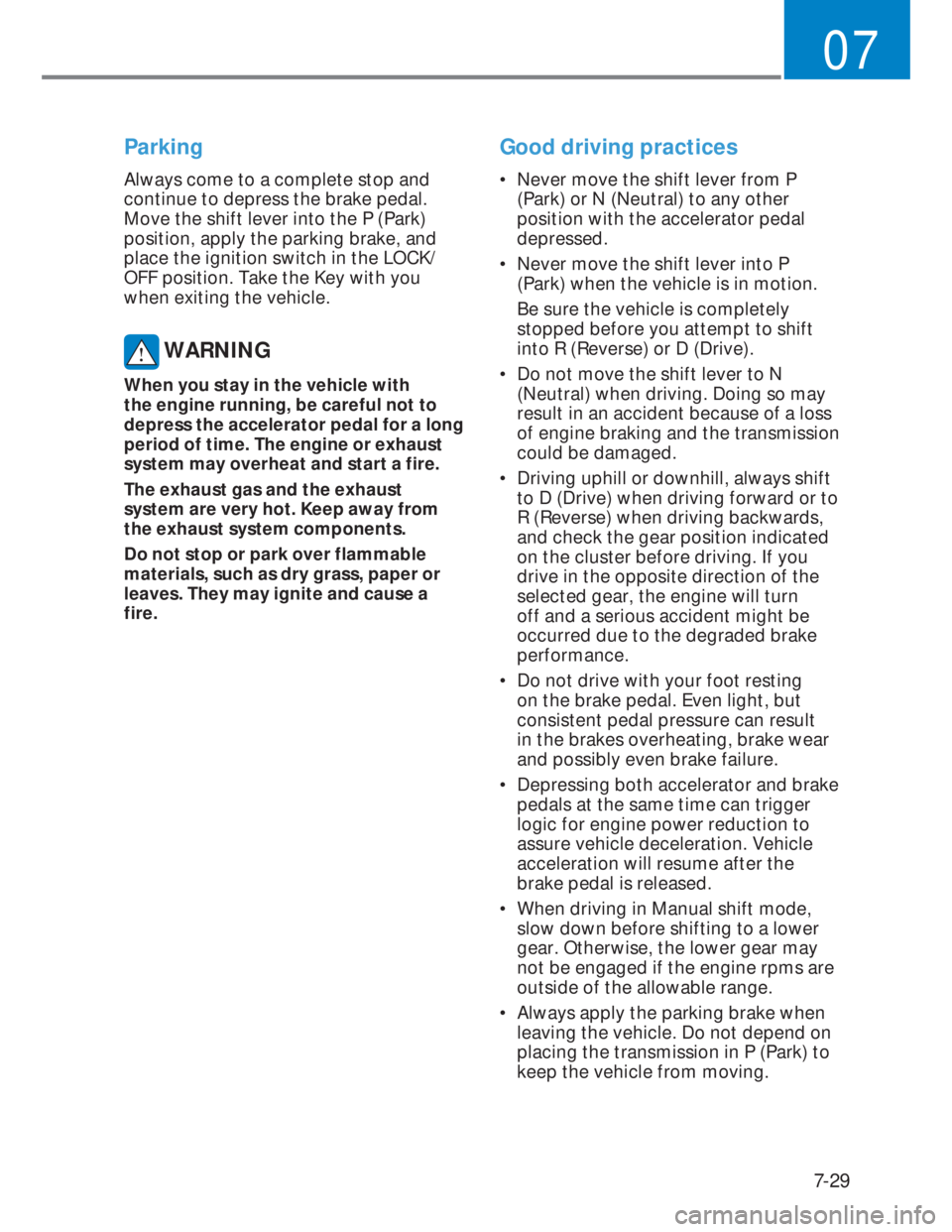
7-29
07
Parking
Always come to a complete stop and
continue to depress the brake pedal.
Move the shift lever into the P (Park)
position, apply the parking brake, and
place the ignition switch in the LOCK/
OFF position. Take the Key with you
when exiting the vehicle.
WARNING
When you stay in the vehicle with
the engine running, be careful not to
depress the accelerator pedal for a long
period of time. The engine or exhaust
system may overheat and start a fire.
The exhaust gas and the exhaust
system are very hot. Keep away from
the exhaust system components.
Do not stop or park over flammable
materials, such as dry grass, paper or
leaves. They may ignite and cause a
fire.
Good driving practices
• Never move the shift lever from P
(Park) or N (Neutral) to any other
position with the accelerator pedal
depressed.
• Never move the shift lever into P
(Park) when the vehicle is in motion.
Be sure the vehicle is completely
stopped before you attempt to shift
into R (Reverse) or D (Drive).
• Do not move the shift lever to N
(Neutral) when driving. Doing so may
result in an accident because of a loss
of engine braking and the transmission
could be damaged.
• Driving uphill or downhill, always shift
to D (Drive) when driving forward or to
R (Reverse) when driving backwards,
and check the gear position indicated
on the cluster before driving. If you
drive in the opposite direction of the
selected gear, the engine will turn
off and a serious accident might be
occurred due to the degraded brake
performance.
• Do not drive with your foot resting
on the brake pedal. Even light, but
consistent pedal pressure can result
in the brakes overheating, brake wear
and possibly even brake failure.
• Depressing both accelerator and brake
pedals at the same time can trigger
logic for engine power reduction to
assure vehicle deceleration. Vehicle
acceleration will resume after the
brake pedal is released.
• When driving in Manual shift mode,
slow down before shifting to a lower
gear. Otherwise, the lower gear may
not be engaged if the engine rpms are
outside of the allowable range.
• Always apply the parking brake when
leaving the vehicle. Do not depend on
placing the transmission in P (Park) to
keep the vehicle from moving.
Page 279 of 444
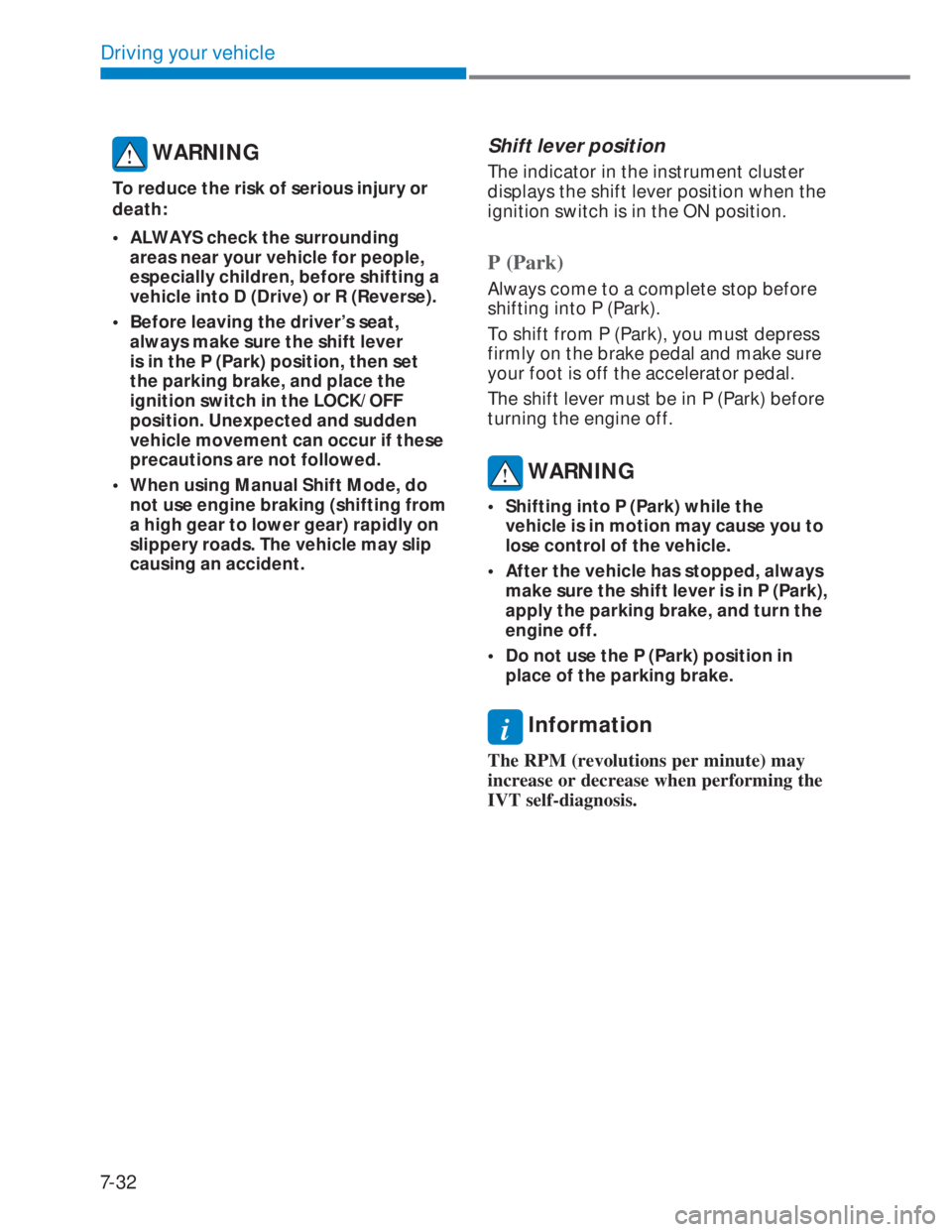
7-32
Driving your vehicle
WARNING
To reduce the risk of serious injury or
death:
• ALWAYS check the surrounding
areas near your vehicle for people,
especially children, before shifting a
vehicle into D (Drive) or R (Reverse).
• Before leaving the driver’s seat,
always make sure the shift lever
is in the P (Park) position, then set
the parking brake, and place the
ignition switch in the LOCK/OFF
position. Unexpected and sudden
vehicle movement can occur if these
precautions are not followed.
• When using Manual Shift Mode, do
not use engine braking (shifting from
a high gear to lower gear) rapidly on
slippery roads. The vehicle may slip
causing an accident.
Shift lever position
The indicator in the instrument cluster
displays the shift lever position when the
ignition switch is in the ON position.
P (Park)
Always come to a complete stop before
shifting into P (Park).
To shift from P (Park), you must depress
firmly on the brake pedal and make sure
your foot is off the accelerator pedal.
The shift lever must be in P (Park) before
turning the engine off.
WARNING
• Shifting into P (Park) while the
vehicle is in motion may cause you to
lose control of the vehicle.
• After the vehicle has stopped, always
make sure the shift lever is in P (Park),
apply the parking brake, and turn the
engine off.
• Do not use the P (Park) position in
place of the parking brake.
i Information
The RPM (revolutions per minute) may
increase or decrease when performing the
IVT self-diagnosis.
Page 283 of 444
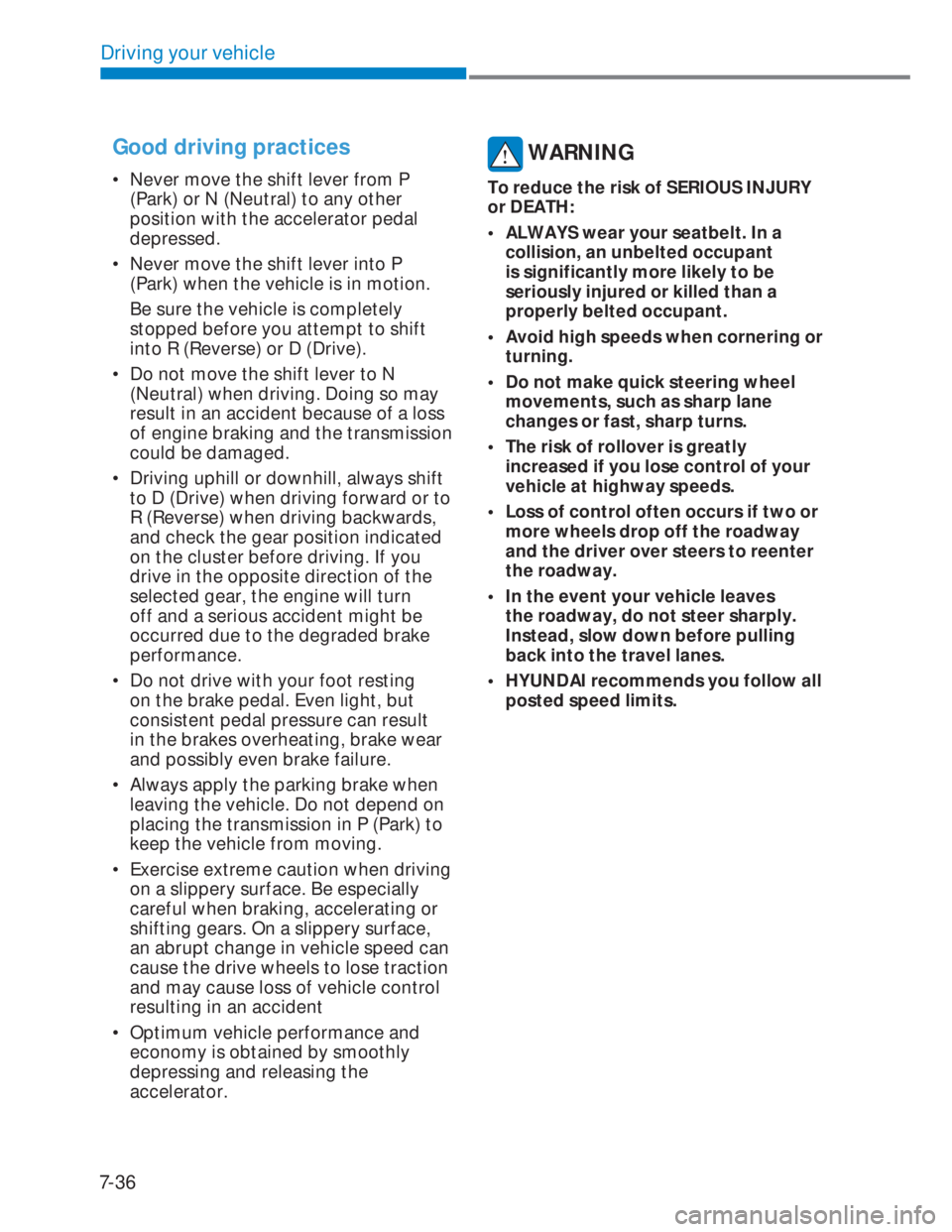
7-36
Driving your vehicle
Good driving practices
• Never move the shift lever from P
(Park) or N (Neutral) to any other
position with the accelerator pedal
depressed.
• Never move the shift lever into P
(Park) when the vehicle is in motion.
Be sure the vehicle is completely
stopped before you attempt to shift
into R (Reverse) or D (Drive).
• Do not move the shift lever to N
(Neutral) when driving. Doing so may
result in an accident because of a loss
of engine braking and the transmission
could be damaged.
• Driving uphill or downhill, always shift
to D (Drive) when driving forward or to
R (Reverse) when driving backwards,
and check the gear position indicated
on the cluster before driving. If you
drive in the opposite direction of the
selected gear, the engine will turn
off and a serious accident might be
occurred due to the degraded brake
performance.
• Do not drive with your foot resting
on the brake pedal. Even light, but
consistent pedal pressure can result
in the brakes overheating, brake wear
and possibly even brake failure.
• Always apply the parking brake when
leaving the vehicle. Do not depend on
placing the transmission in P (Park) to
keep the vehicle from moving.
• Exercise extreme caution when driving
on a slippery surface. Be especially
careful when braking, accelerating or
shifting gears. On a slippery surface,
an abrupt change in vehicle speed can
cause the drive wheels to lose traction
and may cause loss of vehicle control
resulting in an accident
• Optimum vehicle performance and
economy is obtained by smoothly
depressing and releasing the
accelerator.
WARNING
To reduce the risk of SERIOUS INJURY
or DEATH:
• ALWAYS wear your seatbelt. In a
collision, an unbelted occupant
is significantly more likely to be
seriously injured or killed than a
properly belted occupant.
• Avoid high speeds when cornering or
turning.
• Do not make quick steering wheel
movements, such as sharp lane
changes or fast, sharp turns.
• The risk of rollover is greatly
increased if you lose control of your
vehicle at highway speeds.
• Loss of control often occurs if two or
more wheels drop off the roadway
and the driver over steers to reenter
the roadway.
• In the event your vehicle leaves
the roadway, do not steer sharply.
Instead, slow down before pulling
back into the travel lanes.
• HYUNDAI recommends you follow all
posted speed limits.
Page 286 of 444
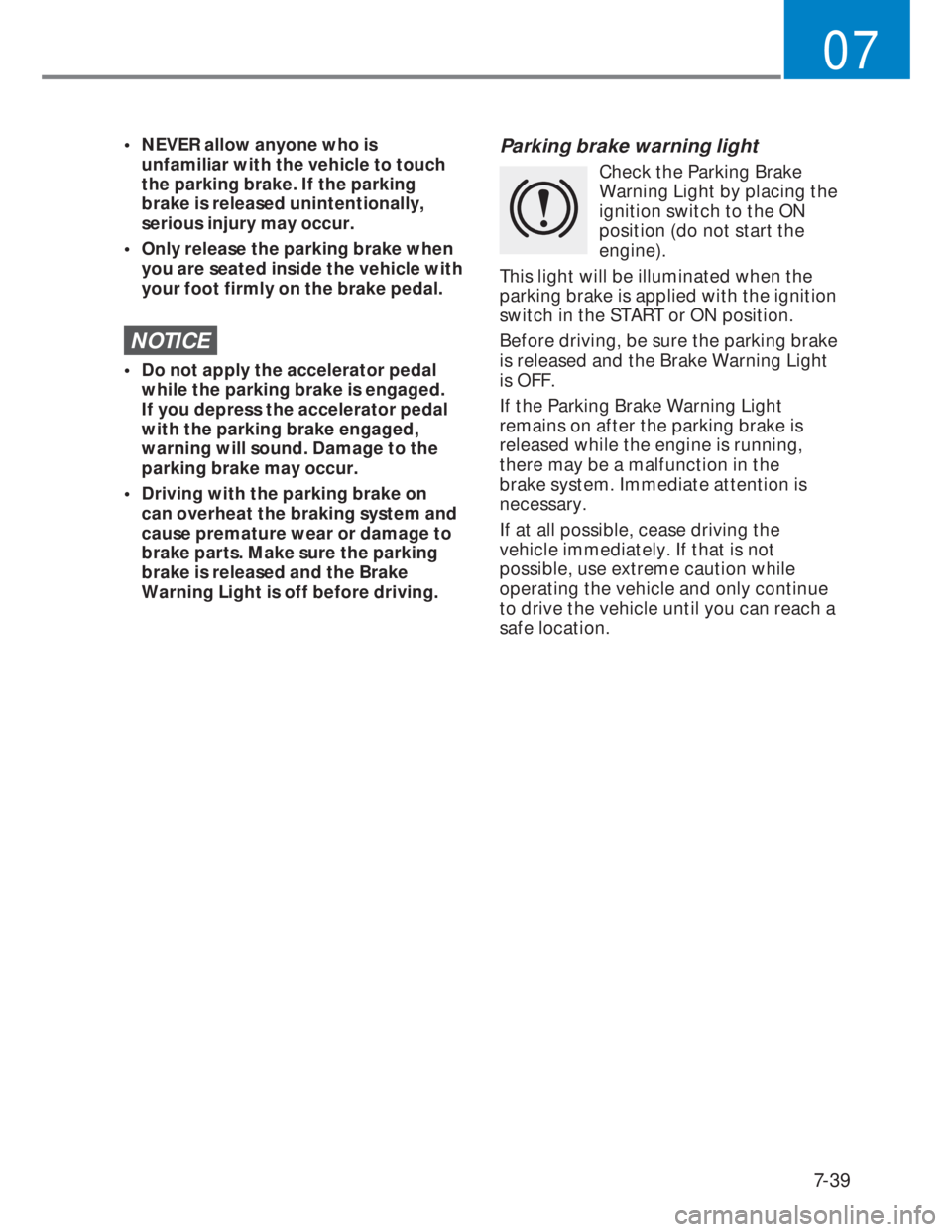
7-39
07
• NEVER allow anyone who is
unfamiliar with the vehicle to touch
the parking brake. If the parking
brake is released unintentionally,
serious injury may occur.
• Only release the parking brake when
you are seated inside the vehicle with
your foot firmly on the brake pedal.
NOTICE
• Do not apply the accelerator pedal
while the parking brake is engaged.
If you depress the accelerator pedal
with the parking brake engaged,
warning will sound. Damage to the
parking brake may occur.
• Driving with the parking brake on
can overheat the braking system and
cause premature wear or damage to
brake parts. Make sure the parking
brake is released and the Brake
Warning Light is off before driving.
Parking brake warning light
Check the Parking Brake
Warning Light by placing the
ignition switch to the ON
position (do not start the
engine).
This light will be illuminated when the
parking brake is applied with the ignition
switch in the START or ON position.
Before driving, be sure the parking brake
is released and the Brake Warning Light
is OFF.
If the Parking Brake Warning Light
remains on after the parking brake is
released while the engine is running,
there may be a malfunction in the
brake system. Immediate attention is
necessary.
If at all possible, cease driving the
vehicle immediately. If that is not
possible, use extreme caution while
operating the vehicle and only continue
to drive the vehicle until you can reach a
safe location.
Page 288 of 444

7-41
07
WARNING
If the ABS warning light () is on and
stays on, you may have a problem with
the ABS. Your power brakes will work
normally. To reduce the risk of serious
injury or death, we recommend that
you contact your HYUNDAI dealer as
soon as possible.
NOTICE
When you drive on a road having poor
traction, such as an icy road, and apply
your brakes continuously, the ABS will
be active continuously and the ABS
warning light (
) may illuminate. Pull
your vehicle over to a safe place and
turn the engine off.
Restart the engine. If the ABS warning
light is off, then your ABS system is
normal.
Otherwise, you may have a problem
with your ABS system. We recommend
that you contact an authorized
HYUNDAI dealer as soon as possible.
i Information
When you jump start your vehicle
because of a drained battery, the ABS
warning light (
) may turn on at the
same time. This happens because of the
low battery voltage. It does not mean your
ABS is malfunctioning. Have the battery
recharged before driving the vehicle.
Electronic Stability Control
(ESC) (if equipped)
OBI3060006OBI3060006
The Electronic Stability Control (ESC)
system helps to stabilize the vehicle
during cornering maneuvers.
ESC checks where you are steering and
where the vehicle is actually going.
ESC applies braking pressure to any one
of the vehicle’s brakes and intervenes in
the engine management system to assist
the driver with keeping the vehicle on
the intended path. It is not a substitute
for safe driving practices. Always adjust
your speed and driving to the road
conditions.
WARNING
Never drive too fast for the road
conditions or too quickly when
cornering. The ESC system will not
prevent accidents.
Excessive speed in turns, abrupt
maneuvers, and hydroplaning on wet
surfaces can result in severe accidents.